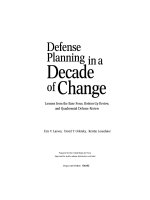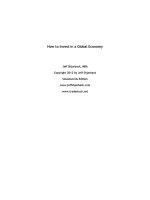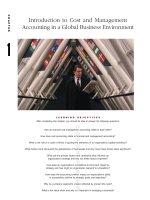R11 estate planning in a global context
Bạn đang xem bản rút gọn của tài liệu. Xem và tải ngay bản đầy đủ của tài liệu tại đây (270.07 KB, 30 trang )
Reading 11
Estate Planning in a Global Context
www.irfanullah.co
Graphs, charts, tables, examples, and figures are copyright 2014, CFA Institute. Reproduced
and republished with permission from CFA Institute. All rights reserved.
Contents
1.
2.
3.
4.
5.
6.
Introduction
Domestic Estate Planning: Some Basic Concepts
Core Capital and Excess Capital
Transferring Excess Capital
Estate Planning Tools
Cross Border Estate Planning
www.irfanullah.co
2
1. Introduction
• Estate planning is an important component of wealth
management
– Inheritance planning
– Business succession
– Charity
– Wills
– Tax planning
www.irfanullah.co
3
2. Domestic Estate Planning: Basic Concepts
Estate: A property a person owns or controls
Estate Planning: Process of preparing for disposition of one’s estate
Will (testament): Rights others will have over one’s property after death
Testator: Person who authors the will and whose property is disposed according to
the will
Probate: Legal process to confirm validity of the will
A person without a valid will dies intestate
www.irfanullah.co
4
2.2 Legal Systems, Forced Heirship and Marital Property Regimes
Civil Law: Derived from Roman Law. Apply rules or concepts to particular cases. Deductive reasoning.
Common Law: Derived from British Law: Draw rules from specific cases. Inductive reasoning.
Legal concept of trust is unique to common law.
Shari’a Law: More like civil law
Forced Heirship:
Children have a right to fixed share of parent’s estate
Community Property Regime: Each spouse has indivisible one-half interest in income earned during marriage
On death half property goes to spouse. Other half divided according to will.
Separate Property Regimes: Each spouse is able to own and control property as an individual.
Read Example 1
www.irfanullah.co
5
2.3 Income, Wealth and Wealth Transfer Taxes
Taxes levied in four ways: 1) Tax on income 2) Tax on spending 3) Tax on wealth and
4) Tax on wealth transfer
Understand how assets are taxed when their ownership is transferred at or before death
Lifetime gratuitous (inter vivos) transfer: transfer made during life-time of the donor
Tax depends on jurisdiction
Testamentary gratuitous transfer: transfer made upon one’s death
Tax on wealth transfer may be applied to transferor or recipient depending on jurisdiction
Example 2
Example 3
www.irfanullah.co
6
3. Core Capital and Excess Capital
Exhibit 1: Hypothetical Life Balance Sheet
Assets
Liabilities and Equities
House
Equity Investments
Fixed Investments
Other Investments
Mortgage
College
Net Employment Capital
(Human Capital)
Current Lifestyle
Retirement
Excess Capital
Core Capital: Capital required to 1) maintain lifestyle 2) fund primary goals and
3) meet unexpected commitments
Excess Capital
www.irfanullah.co
7
3.1 Estimating Core Capital with Mortality Tables
Simplest approach: Calculate PV of anticipated spending over remaining life expectancy
What is the problem with this approach?
Another approach: multiply each future cash flow by survival probability
If husband/wife are relying on the same core capital…
P (S) = P(H) + P(W) – P(HW)
www.irfanullah.co
8
www.irfanullah.co
9
Embedded example: Ernest, 79 and Beatrice, 68.
Probability of survival in year 1: P(E) = 0.936 P(B) = 0.983
What is the probability that either or both survive in year 1?
Refer to Exhibit 2
Annual spending in year 1 = 500,000. What is the expected spending in year 1?
What is the present value using a real risk free discount rate of 2%?
Assume real growth rate of expected spending is 3%. What is the expected spending
in year 2?
Core capital requirement = €9.2 million
Why should we discount at risk free rate rather than expected rate of return on
investments?
www.irfanullah.co
10
Safety Reserve
Augment core capital with a safety reserve
This helps address 1) lower asset returns than expected and 2) higher expenditure than expected
Example 4
www.irfanullah.co
11
3.2 Estimating Core Capital with Monte Carlo Analysis
Forget discounting!
This method estimate size of portfolio needed to meet expenses
Captures capital market risks much better than mortality table approach
Forecast portfolio values given statistical properties of underlying asset returns
Forecast spending needs
www.irfanullah.co
12
Calculate sustainable spending rates without simulation
Example 5
www.irfanullah.co
13
4. Transferring Excess Capital
Webster’s have €20,000,000 and need core capital = €9,200,000. What is their challenge?
If inheritance tax consider gifting
Tax-Free Gifts
In the US a parent can gift $13,000 per child per year
Exhibit 4. 13,000/year tax free for 30 years
8% nominal return, tax = 25%, inflation = 2.5%
www.irfanullah.co
14
Relative Value of a Tax-Free Gift:
www.irfanullah.co
15
Taxable Gifts
Relative Value of Taxable Gifts
www.irfanullah.co
16
Location of the Gift Tax Liability
Preceding section assumes tax is paid by recipient
In some countries donor pays tax
Tax benefit of lifetime gift vs. bequest increases
Exhibit 6
Example 6
www.irfanullah.co
17
4.2 Generation Skipping
If wealth transfer goals extend beyond second generation…
200,000,000 allocated for third generation. 5% growth. 35 years. 50% gift tax.
Scenario 1: Transferred to second generation after 10 years. Transferred to third generation after 25 more years
Scenario 2: Transferred to third generation after 35 years.
www.irfanullah.co
18
4.3 Spousal Exemptions
UK: Estate less than GBP 312,000 can be transferred to spouse without inheritance tax
4.4 Valuation Discounts
Gift and estate taxes can be mitigated by transferring assets that qualify for valuation discounts
Privately held family business Discount for lack of liquidity
www.irfanullah.co
19
4.5 Deemed Dispositions
Treat bequest as if the property were sold
4.6 Charitable Gratuitous Transfers
Most charitable donations are not subject to a gift transfer tax
Charitable organizations exempt from paying tax on investment returns
Gifts to charitable organizations are tax deductible
Relative Value:
Example 7
www.irfanullah.co
20
5. Estate Planning Tools
Gratuitous transfers are often implemented through structures that:
1) Maximize tax benefit and/or
2) Produce a non-tax benefit
Common estate planning tools:
1) Trusts (common law concept)
2) Foundations (civil law concept)
3) Life insurance
4) Companies
www.irfanullah.co
21
Trusts
Settlor (or grantor) transfers assets to trustee.
Trustee holds and manages assets for benefit of
beneficiary
Irrevocable trust
Trustee responsible for tax payments
Less vulnerable to creditor claims
Revocable trust: Settlor retains right to rescind
Settlor responsible for tax payments
Vulnerable to creditor claims
Fixed trust
Fixed payment
Fixed periods
Discretionary trust
Trustee decides whether and how much
to pay
Benefits:
1) Avoid probate
2) Make resources available to beneficiaries without yielding control
3) Protection from creditors
4) Tax reduction
www.irfanullah.co
22
Foundations
Foundations are set up to hold assets for a particular purpose. Example: promote education
Like trusts, foundations survive settlor
Life Insurance
Policy holder transfers assets (premium) to insurer
Insurer has obligation to pay death benefit to beneficiary
Benefits:
1) Lower taxes
2) Avoid probate
3) Protection from creditors
www.irfanullah.co
23
Companies and Controlled Foreign Corporations (CFC)
Place income generating assets in CFC
Benefits:
1) Tax deferred until income is distributed
2) Establish in country with no taxes
Many countries have CFC rules designed to prevent tax payers from avoiding taxation
www.irfanullah.co
24
6. Cross-Border Estate Planning
Income generated outside home country may be taxed in both countries
Passing ownership of overseas assets on death might be difficult
Transferring assets to heirs located outside home country might be difficult
The Hague Conference: Intergovernmental organization that works toward the convergence of private
international laws.
www.irfanullah.co
25









![early adulthood in a family context [electronic resource]](https://media.store123doc.com/images/document/14/y/cq/medium_cqx1401353169.jpg)